
Ukraine’s Energy Battle: A Third Winter of War Poses the Greatest Challenge Yet
Section 1: Ukraine’s Deteriorating Energy Environment
Since the conflict with Russia began in 2014, Ukraine’s energy supply system has been put under enormous pressure. This forthcoming winter threatens to pose the sternest challenge yet. Amid escalating tensions and an ongoing economic intervention, the wearing down of the country’s coal resources, sanctions on Russian gas, and depreciation of the local currency are all factors contributing to an energy crisis that might escalate as temperature levels drop.
Section 2: The Struggles with Coal
Coal usually occupies a significant place in the structure of Ukraine’s energy supply. However, the story has taken a dramatic turn since the majority of Ukraine’s anthracite coal mines – the type responsible for most of its electricity generation – are located in the war-torn areas of Donetsk and Luhansk. As a result, the sector has witnessed a steep decline. Coal availability has dwindled significantly, and the stocked quantities are not expected to last beyond the winter.
Section 3: Dependence on Russian Gas
Natural gas has been a major component of Ukraine’s energy mix. However, Ukraine heavily depends on imports, especially from Russia, to meet its demand. The ongoing geopolitical turmoil, coupled with Russia’s inclination to use gas supply as a tool for political leverage, has led to disruptions in flow and high price fluctuations. Sanctions imposed on Russia by the international community have further exacerbated the situation, rendering an already complex scenario even more challenging.
Section 4: Devaluation of the Hryvnia
Ukraine’s local currency, the Hryvnia, has substantially depreciated over the past few years. Low confidence in the country’s economic stability is the main factor behind such depreciation. This scenario has significantly impacted the affordability of imported energy and increased the costs for maintaining and upgrading the country’s aging energy infrastructure.
Section 5: Government Measures and Efforts
To lessen the impact on the citizens and meet the demand, several measures have been taken by the government and energy companies. Bilateral agreements with neighboring countries for alternative gas supplies, investment in renewable energy technologies, energy conservation campaigns, and initiatives to upgrade the energy infrastructure are among these measures. However, the success of these actions under the persisting war conditions remains uncertain.
Section 6: The Role of International Community
Addressing this crisis requires global effort and solidarity. The international community plays a critical role in supporting Ukraine, providing financial aid, medical help, and humanitarian support, as well as
